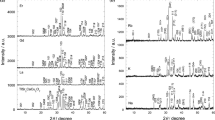Abstract
In the paper by K. Rajput and S. Vitta published in the present journal the synthesis and the thermoelectric properties of the dysprosium containing clathrate Dy8Al16Si30 were reported. We prepared two samples following exactly to the technique described in the paper. Our XRD and SEM/EDX investigations do not confirm the presence of any amount of a Dy-containing clathrate phase in the sample.
Similar content being viewed by others
In the recent paper by K. Rajput and S. Vitta [1] the synthesis and the thermoelectric properties of the dysprosium containing clathrate Dy8Al16Si30 were reported. The authors obtained by melting the elementary metals a polyphase material containing, as claimed by the authors, the clathrate phase. This conclusion was made on the basis of X-ray powder diffraction (XRD) of the polyphase sample. However, in our opinion, the diffraction pattern and the Rietveld analysis given in the paper do not provide strong evidence of the presence of the clathrate phase. The authors investigated the sample also using the scanning electron microscopy (SEM) with energy dispersive X-ray spectral analysis (SEM/EDX). However, only the total composition of the sample and not that of the individual phases was reported.
We prepared a sample following exactly to the technique described in the paper (Tetra-Arc Techno Search) with annealing of a part of the sample at 780 K for 7 days. The as-cast and the annealed samples were characterized by XRD (PANalytical XPert Pro MPD, X-ray Center TUWien) and SEM/EDX (Philips XL30 ESEM, EDAX New XL-30 135-10 UTW). The powder diffraction patterns obtained by us were very similar to the reported in Ref. [1]. The Rietveld refinement of the samples (Rwpr = 2.8 %) yields the following phases (mass. %): as-cast sample—Si 45, DySi2 22, DyAl2Si2 17, Al 16; annealed sample—Si 59, DyAl2Si2 28, DySi1.78 4; Al 7, Dy2Al3Si2 2 (Fig. 1).
No clathrate phase was detected in both our samples. Although the diffraction pattern of the Dy-clathrate is not available, it can be simulated based on the existing Ba- and Sr-containing analogues. Substitution of Ba with its ionic radius (r ion ) of 1.47 Å by Sr with r ion = 1.31 Å results in a contraction of the unit cell from a = 10.632 to 10.465 Å [2, 3]. Linear extrapolation to the ionic radius of Dy3+ r ion = 1.083 Å leads to a value of a = 10.23 Å for the lattice constant of the Dy-clathrate. Using this value and replacing the scattering factor of Ba by that of Dy we obtained the diffraction pattern of a hypothetical Dy-clathrate which is shown in Fig. 1 as a line diagram.
The polished surfaces of the samples were analyzed by SEM with EDX measurements of the compositions of all individual constituting phases (Fig. 2). The analysis confirms the presence of phases found by the powder diffraction.
No phase with the generic composition A8B46 characteristic of a type-I clathrate was found.
Thus both XRD and SEM/EDX do not confirm the presence of any amount of a Dy-containing clathrate phase in the sample prepared according to [1].
References
K. Rajput, S. Vitta, J. Mater. Sci. Mater. Electron. (2016). doi:10.1007/s10854-016-5113-1
N. Tsujii, J.H. Roudebush, A. Zevalkink, C.A. Cox-Uvarov, G.J. Snyder, S.M. Kauzlarich, J. Solid State Chem. 184, 1293 (2011)
J.H. Roudebush, N. Tsujii, A. Hurtando, H. Hope, Y. Grin, S.M. Kauzlarich, Inorg. Chem. 51, 4161 (2012)
Acknowledgements
Open access funding provided by TU Wien (TUW).
Author information
Authors and Affiliations
Corresponding author
Rights and permissions
Open Access This article is distributed under the terms of the Creative Commons Attribution 4.0 International License (http://creativecommons.org/licenses/by/4.0/), which permits unrestricted use, distribution, and reproduction in any medium, provided you give appropriate credit to the original author(s) and the source, provide a link to the Creative Commons license, and indicate if changes were made.
About this article
Cite this article
Himmelbauer, T., Prokofiev, A. Comments on “Thermoelectric properties of rare earth containing type-I clathrate compound, Dy8Al16Si30”. J Mater Sci: Mater Electron 28, 1147–1148 (2017). https://doi.org/10.1007/s10854-016-5666-z
Received:
Accepted:
Published:
Issue Date:
DOI: https://doi.org/10.1007/s10854-016-5666-z






